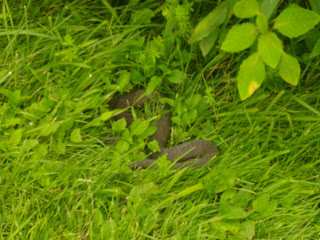What is the point of a City Park? Part One

Yesterday morning I took a ride down to the parkway and went for a walk. It was my intention to revisit the part of the Parkway that I documented the first time I decided I was going to write a blog about city parks. I went because the summer is all but faded now and the hands of autumn are stretching across us like a greedy child upon a bowl of candies.

I went to reflect on the long summer. I went to start trying to figure out what exactly the point of city parks is. You see, I have been watching the wonderful Ken Burns Documentary on our National Parks. The explanations offered by historians and historical figures for the purposes of our National Parks are as psychologically inspiring as our parks are awe inspiring. These huge swatches of wild land are America’s greatest legacy and our most enduring monuments.

Listening to the words of the prophet of the wilderness, John Muir, I was left a bit shell shocked. I am no Muir as I visit the parks of Allentown, take a few pictures and write a bit about them on this blog. I wish I had half the intellect and talent that John Muir had. Muir walked to the Sierra Nevada Mountains and in doing so bequeathed upon anyone who steps a toe into the wild, a precedent for worship, word and knowledge. Not the worship of a god in a stone building but the worship of wonder by observation and study; words not of poesy or verse but of eyesight and witness; knowledge not of the concrete jungles and urban worlds but of the everlasting presence and eternal weight of nature.

And into the Parkway I went. Autumn had begun to make its presence known selectively on a few maples turned red, leaves swimming in the creek, and the general fade of everything from lush leaves and color to space and barrenness. Now and again, where autumn’s fingers haven’t reached it would seem to still be July, just briefly.
I climbed upon an outcropping of rock, sat and watched.

The trees were shaking violently in the wind gusts and their leaves were escaping from branches as if fleeing from an unseen threat. The water of the creek bristled in the breeze and small waves beat against the banks. There was short peace between the winds and a sense of cool calmness even as the slow smell of decay rose into the new afternoon.

Undoubtedly beautiful, but ultimately why? I did not think to stop and ask a passerby their opinion. Most of them were plugged into their iPods or focused on calories; I do not think they would have noticed if all of a sudden their surroundings up and disappeared. To those runners, this place of controlled wilderness is nothing but scenery. The National Parks are true wildernesses. Our city parks are not.

I continued walking and watching. The afternoon was cool and I could not have been more grateful. The sky was genuinely blue, with thick puffs of cumulus clouds being pushed around by the wind. Again, beautiful to be sure but what is the purpose of the Parkway? It certainly must not be a mere place to go running. Perhaps, on a smaller scale, it is exactly the same purpose that Muir saw in the cavernous valleys of Yosemite. Perhaps, John Muir has left a mark so deep in the general psyche of America that his point is ultimately mine.

As I walked on the return loop to my station wagon, I thought next of the trees. I considered what it would be like to be a tree. A tree feels no loss when a leaf falls or a storm claims one of its branches. A tree knows to grow in the direction of sunlight and does not question it. A tree never has to accept consequences because the things that happen to it are just part of the way it goes. A tree never has to move on or mourn or feel the pain of death. A tree never watches someone they love hurt or loses someone they love to someone else. A tree grows. A tree dies.

We will move on, we will mourn and feel the pain of death. We will watch our loved ones hurt. We will lose the ones we love to circumstance. We will grow. We will die. At the end of our day, we are just another animal returning to the dirt from whence we came. We go to the parks to see our mortality painted across the beauty of nature. In the small wild worlds we have in our city there are countless lessons to learn. It is time I explored what the parks have been teaching. Today, in the growing shadow of autumn I realized the first one. Unplug your iPods and listen. We go to the parks to learn, or at the very least, we should.

I leave you today, with this:
Excerpt from Thanatopsis by William Cullen Bryant:
To him who in the love of Nature holds
Communion with her visible forms, she speaks
A various language; for his gayer hours
She has a voice of gladness, and a smile
And eloquence of beauty, and she glides
Into his darker musings, with a mild
And healing sympathy, that steals away
Their sharpness, ere he is aware. When thoughts
Of the last bitter hour come like a blight
Over thy spirit, and sad images
Of the stern agony, and shroud, and pall,
And breathless darkness, and the narrow house,
Make thee to shudder and grow sick at heart;--
Go forth, under the open sky, and list
To Nature's teachings
Labels: The Purpose of City Parks




















